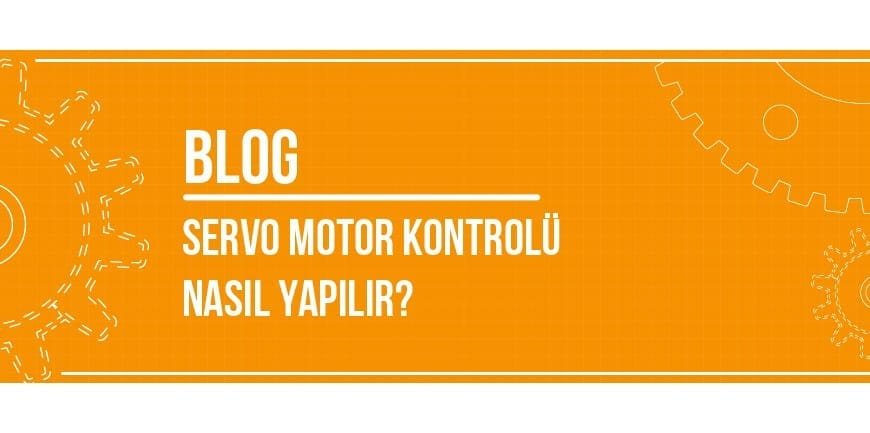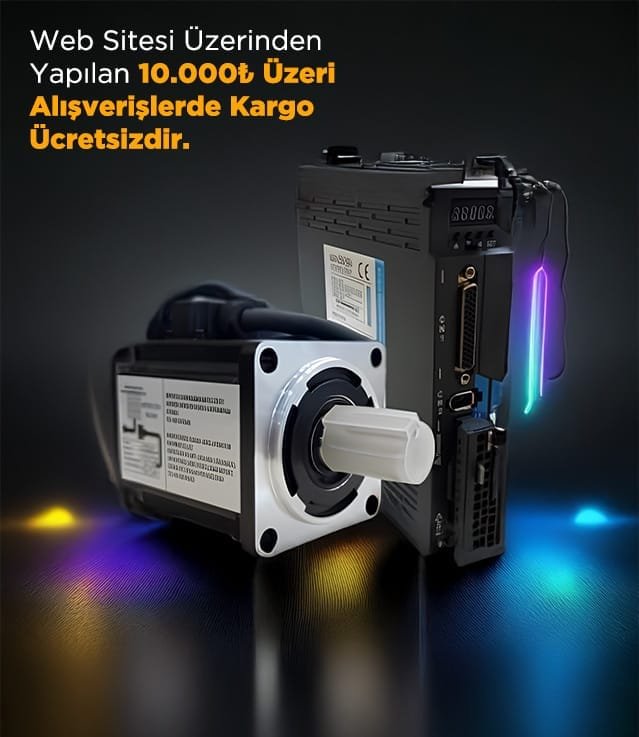
İçindekiler
How to Operate a Buzzer with Servo Motor?
Used in a wide range of applications, from industrial applications to hobby projects, servo motors and buzzers are often used together to fulfill important functions. Servo motors provide precise motion control, while buzzers are the perfect tool for audible warnings and alarm systems. If you want to have more detailed information about using these two components together, you can check our content “How to Operate a Servo Motor and Buzzer”. In this way, you can learn about the working principle of these two components. You can also have an idea about the benefits it provides. We wish you all a good day.
What is a Buzzer?
Buzzer is a device that converts electrical energy into sound energy and is generally preferred in warning, feedback or alarm systems. The main reason for this is that it provides low cost in electronic circuits and at the same time has a compact structure and easy integration feature. In this context, buzzers are widely used in both simple and complex electronic systems, offering suitable solutions for various needs. At the same time, the diversity of usage areas allows buzzers to be preferred in projects where audible warning, feedback and alarm requirements are needed. Thus, digital clocks are widely used in applications such as home appliances, security systems, industrial equipment, automotive indicators and toys.
Buzzer Types
Buzzer types are divided into certain types according to their working principle and usage area. These types are divided into 6 categories. These are; Piezoelectric Buzzer, Electromagnetic Buzzer, Active Buzzer and Passive Buzzer. If we need to examine these buzzer types;
1. Piezoelectric Buzzer
A piezoelectric buzzer is a device that works by vibrating piezoelectric material in response to electrical signals. This device generates sound waves by transforming into mechanical vibrations on the piezoelectric crystal. In this way, high sound levels can be achieved with low energy consumption. It is also widely used in digital clocks, alarm systems, toys and various electronic devices as it can operate in a wide frequency range. With its compact design and economical structure, it is especially ideal for applications that are portable and require low power consumption.
2. Electromagnetic Buzzer
An electromagnetic buzzer has a structure in which the coil inside generates a magnetic field with an electric current, and this field produces sound by vibrating the diaphragm. Such buzzers can usually operate at low frequencies and produce a strong, clear sound. In this context, electromagnetic buzzers are preferred in applications such as automotive systems, security devices and industrial control panels. At the same time, their high sound output and ability to produce different tones make them a popular choice in environments that require audible warning.
3. Active Buzzer
The active buzzer has an internal oscillator and can only operate with a constant electrical signal. In this context, the fact that it does not need an external oscillator or PWM signal makes active buzzers very simple to use. This highly advantageous type of buzzer produces a constant sound at a predetermined frequency when activated and is used in a wide range of applications such as home appliances, alarm systems and toys thanks to its compact design and easy integration.
4. Passive Buzzer
A passive buzzer is a device controlled by an external signal source or oscillator circuit. This device can produce different tones and levels of sound depending on the frequency of the electrical signal. This makes it a more flexible use option.
Passive buzzers are generally preferable for musical projects or applications requiring special sound effects, but their controllability makes them ideal for more complex projects and systems where a variety of audio frequencies are required. However, they require a more complex setup than active buzzers as they require an external signal.
5. Mechanical Buzzer
A mechanical buzzer is a device that uses mechanical vibrations instead of electricity to produce sound. This type of brazzer is usually powered by a vibration motor or a mechanical system. Thus, mechanical buzzers were widely used in older technologies compared to today’s electronic devices. This type of brazzer is rarely used in modern projects due to its low sound level and limited range of use, but its simple structure and low energy requirements make it still possible to use it in some mechanical toys and low-tech devices.
6. Magnetic Buzzer
A magnetic buzzer creates a magnetic field with electrical signals, causing the diaphragm to vibrate and produce sound. At this point, it has a similar working principle to an electromagnetic buzzer, but can operate at higher sensitivity and frequency ranges. These magnetic buzzers are generally preferred in industrial applications that require high volume and durability. They are also widely used in security alarm systems and machine control systems because of their powerful sound output and wide frequency range.
What is the Buzzer Working Principle?
The buzzer working principle is based on the conversion of electrical energy into mechanical vibrations to generate sound waves. Depending on the type of buzzer, this conversion is realized by piezoelectric, electromagnetic or magnetic effects. However, the working principle of each buzzer is different. For this reason, it would be wrong to describe a single working principle. For example; Piezoelectric buzzers work by vibrating the piezoelectric material in response to an electrical signal, while Electromagnetic buzzers are based on the principle that the electric current passing through the coil creates a magnetic field and this field vibrates a metal diaphragm. At this point, in both cases, sounds of different frequencies and intensities are produced as a result of vibration.
Things to Consider When Choosing a Buzzer
There are certain points to consider when choosing a buzzer. By paying attention to these points, you can get maximum efficiency from the buzzers. In this context, here are the things you should pay attention to when choosing a buzzer;
- When choosing a buzzer, first of all, you should pay attention to the type of buzzer. Because these types will help you achieve maximum efficiency by adapting better to the area you will use.
- Depending on the usage environment, buzzers with an adequate sound level should be preferred. For this purpose, a high dB value is preferred for noisy environments, while a lower dB value should be preferred for low-noise environments.
- In addition, a buzzer suitable for the voltage range to be used in the circuit should be selected. In this way, you can achieve better results.
- In buzzer selections, attention should be paid to the sound tone that should be produced. For example; For alarm systems, frequencies between 1kHz-3kHz are generally ideal.
- In addition, for battery-powered devices, low energy consumption buzzers can be considered.
- A buzzer size should be selected according to the design of the device you will use. In particular, small size models can be used for compact designs, while large buzzers can be used for larger designs.
- The preferred Buzzer must also adapt to the temperature conditions of the environment where it will be used. For this, attention should be paid to the wide temperature range, especially in industrial applications.
- Long-lasting and durable models should be preferred for buzzers that will operate continuously.
- A suitable buzzer should be selected, also taking into account the budget of the project. However, low-cost buzzers can often have a shorter lifespan.
- Finally, a buzzer from a reliable manufacturer with quality certificates should be preferred. This way you will not have problems with certification and warranty.
How to Operate a Buzzer with Servo Motors?
Servo motors and buzzers can be easily operated together via microcontrollers and can be used together in many electronic projects. In this context, while the microcontroller enables the servo motor to move at a certain angle, the buzzer can simultaneously produce a sound in a certain tone in synchronization. In this way, motion and audio feedback are provided simultaneously, increasing both functionality and user experience in projects.
In the circuit setup for this process, the control cable of the servo motor is connected to a PWM pin and the buzzer is connected to a digital output pin. If an active buzzer is used, only one digital signal is sufficient. But for a passive buzzer a PWM signal may be required.
In the coding phase, the motion commands of the servo motor and the sound output of the buzzer should be synchronized to provide both motion and audio feedback in applications. In this way, robotic systems can be used in many areas such as security projects and educational applications.
Effect of Buzzer on Servo Motors
The effect of the buzzer on servo motors is advantageous in terms of energy consumption, signal confusion and synchronization, especially when they are used in the same circuit. This is because the buzzer strikes a balance between low energy consumption and high energy requirements of the servomotors and can improve the overall energy efficiency of the system, and when they work in the same circuit, the audible feedback given by the buzzer is synchronized with the servomotor’s movements, letting the user know that the operation is happening correctly. For example, when a servomotor rotates to a certain angle, the buzzer signals each step of movement with a tone, improving interactivity and the verification process in projects.
For example, when a servo motor rotates to a certain angle, the buzzer signals each step of movement with a tone, which improves the interaction and verification process in projects. This is mainly because the buzzer provides instant and direct feedback to the user. Furthermore, the use of an external power supply prevents high current draws, especially from the servo motor, from affecting the performance of the buzzer. As a result, the integration of buzzer and servo motors offers great advantages to projects in terms of energy efficiency, audible feedback and motion accuracy.
When is Buzzer Used in Servo Motors?
The buzzer is often used in conjunction with servo motors for motion verification, signaling and providing feedback. Especially in robotic systems, the buzzer provides audible feedback to indicate that the servo motor has moved to a certain position or to indicate that a step has been successfully completed. This allows the user to understand whether the movement of the motor has been performed correctly.
In security applications, the buzzer provides information about the status of the system by giving an audible warning to the users in the opening and closing processes of barriers, gates or control mechanisms powered by servo motors. In addition, in educational projects, the combination of buzzer and servo motor makes learning processes more effective by marking each movement with a tone. Also, in automation systems, the buzzer makes the system more reliable by alerting the user when the servo motor completes its movement or when a problem occurs in the operation of the motor. Therefore, the buzzer is an effective component to increase user interaction with servo motors, ensure safety and facilitate system operation.
How to Connect Buzzer to Servo Motors?
To connect the buzzer and servo motors, it is necessary to connect them to the same microcontroller. For this, it is first necessary to connect both components to the correct pins. If you are using a microcontroller like Arduino, the buzzer is usually connected via a digital pin, while the servo motor is connected to one of the PWM (Pulse Width Modulation) pins. For example, when connecting a buzzer and servo motor using Arduino, you connect one end of the buzzer to GND (ground) and the other to a digital pin (for example, D2).
Then you connect the control cable of the servo motor to one of the Arduino’s PWM pins (for example, D9). Then, on the code side, a HIGH (1) signal is sent via the digital pin output to activate the buzzer, while to control the servo motor, the servo library is used to set the desired angle with the PWM signal. In this way, after a certain servo motor movement, the buzzer can be activated and sound an alarm.
But the most important thing to remember is . The code for Arduino or other microcontrollers must be written in such a way that it directs the buzzer to produce a sound and the servo motor to move. Otherwise, the desired result may not be achieved.
The Role of Buzzer and Servo Motors in Industrial Applications
In industrial automation and control systems, buzzers and servo motors fulfill various critical functions, making production processes safer, more efficient and error-free. At this point, buzzers are often used as a warning or alarm system. They also provide audible warnings for malfunctions, dangerous situations or critical moments that require attention in production lines or machines. It is also common to use buzzers for alarm systems reminding of maintenance time or periodic inspection requirements for machines operating in industrial plants.
Servo motors play an important role in any application that requires precise and controllable motion. In industrial robotic systems, automated assembly lines, 3D printers and CNC machines, servo motors enable motors to rotate at specific angles and speeds, realizing high-precision and repeatable movements. In particular, servo motors ensure accurate positioning of robot arms or assembly elements and improve quality in production processes. Servo motors are also used in automated packaging systems, conveyor belts and automatic control systems to ensure speed and motion accuracy. These motors optimize motion control in industrial applications, increasing efficiency and minimizing operational errors.
When both components are used together, industrial automation systems become more effective and reliable. For example, when a robot arm stops or moves in a certain position via a servo motor, the operator can be alerted with a buzzer sound. This kind of integration increases work safety and ensures uninterrupted system operation by detecting potential faults early. Buzzers and servomotors are therefore critical components in industrial systems, with both devices helping to keep processes running smoothly and safely.
If you are in search of servo motors suitable for buzzers, contact Şahin Rulman’s expert team immediately and find the servo motor you need. you can have servo motors.
FAQ
Can I use separate power supplies for servo motor and buzzer?
The same power supplies can be used for the servo motor and the buzzer. However, both power supplies must be connected to the ground (GND) line. Otherwise the circuit may not function properly or the circuit may be damaged.
How to synchronize the buzzer sound when the servo motor is moving?
The motion commands of the servo motor and the sound output commands of the buzzer can be synchronized with a software via the microcontroller. For this, PWM (Pulse Width Modulation) and digital output features of the microcontroller can be utilized. Thus, the buzzer sound is synchronized.
Can servo motor and buzzer be controlled from the same microcontroller?
Servo motors and buzzers can be controlled with the same microcontrollers. Because . While the servo motor is controlled with one of the PWM pins, the buzzer can be operated by connecting to a digital or PWM pin. Thus, they are controlled from the same microcontroller.
Which type of buzzer is more compatible with a servo motor?
The active buzzer is more suitable for use with a servo motor. This is mainly because it does not require an external signal or oscillator. In this context, if you use a passive buzzer, you need to write code that generates PWM signals.
How to make the servo motor and buzzer work at the same time?
A software is required for this. With this software, the movement of the servo motor and the buzzer sound can be controlled simultaneously.
Diğer Blog Yazılarımız








